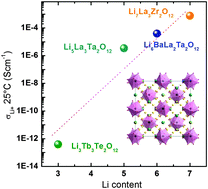Garnet-type solid-state fast Li ion conductors for Li batteries: critical review
Abstract
Batteries are electrochemical devices that store electrical energy in the form of chemical energy. Among known batteries, Li ion batteries (LiBs) provide the highest gravimetric and volumetric energy densities, making them ideal candidates for use in portable electronics and plug-in hybrid and electric vehicles. Conventional LiBs use an organic polymer electrolyte, which exhibits several safety issues including leakage, poor chemical stability and flammability. The use of a solid-state (ceramic) electrolyte to produce all-solid-state LiBs can overcome all of the above issues. Also, solid-state Li batteries can operate at high voltage, thus, producing high power density. Various types of solid Li-ion electrolytes have been reported; this review is focused on the most promising solid Li-ion electrolytes based on garnet-type metal oxides. The first studied Li-stuffed garnet-type compounds are Li5La3M2O12 (M = Nb, Ta), which show a Li-ion conductivity of ∼10−6 at 25 °C. La and M sites can be substituted by various metal ions leading to Li-rich garnet-type electrolytes, such as Li6ALa2M2O12, (A = Mg, Ca, Sr, Ba, Sr0.5Ba0.5) and Li7La3C2O12 (C = Zr, Sn). Among the known Li-stuffed garnets, Li6.4La3Zr1.4Ta0.6O12 exhibits the highest bulk Li-ion conductivity of 10−3 S cm−1 at 25 °C with an activation energy of 0.35 eV, which is an order of magnitude lower than that of the currently used polymer, but is chemically stable at higher temperatures and voltages compared to polymer electrolytes. Here, we discuss the chemical composition–structure–ionic conductivity relationship of the Li-stuffed garnet-type oxides, as well as the Li ion conduction mechanism.


 Please wait while we load your content...
Please wait while we load your content...